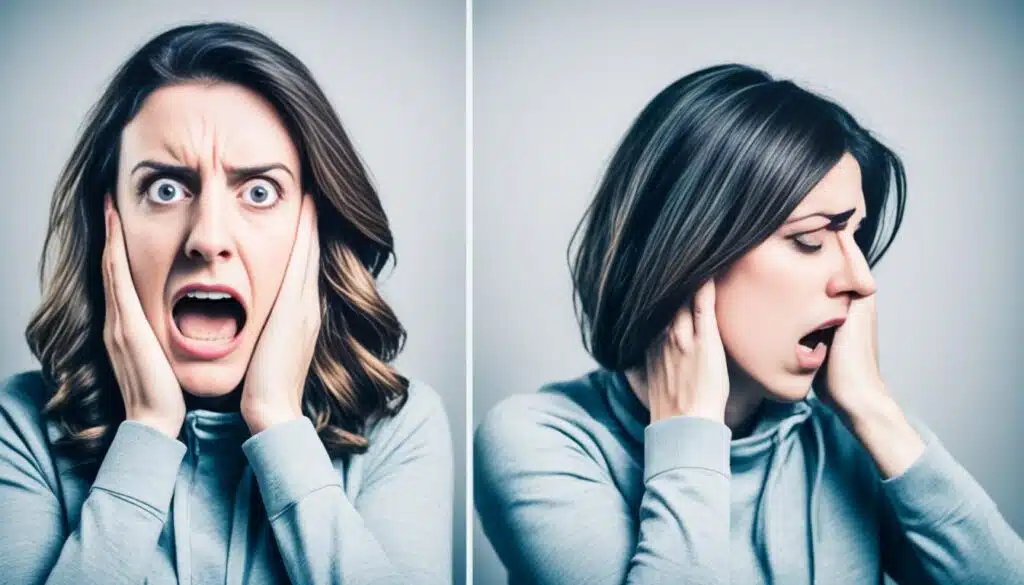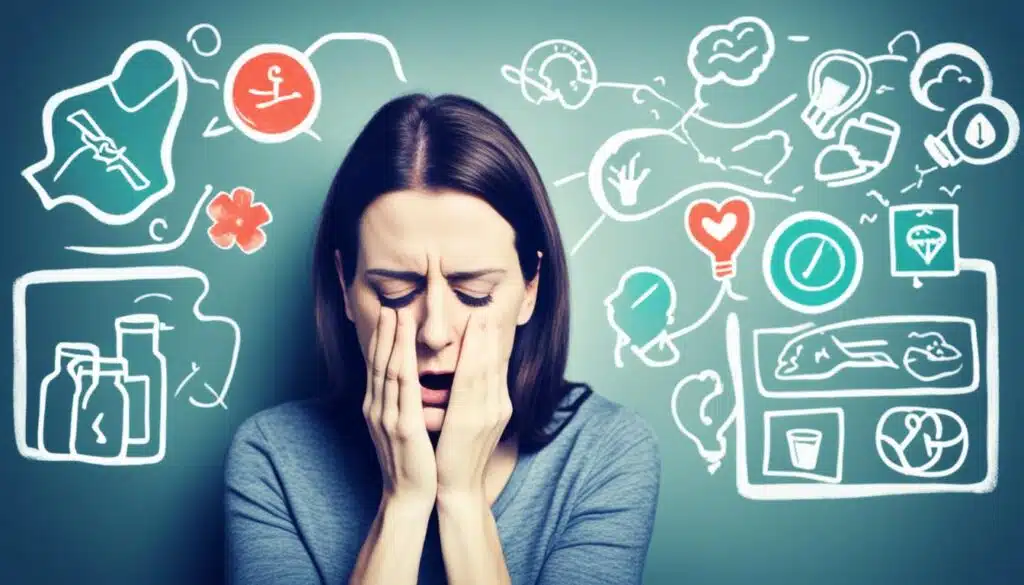When it comes to mental health, Panic Attack And An Anxiety Attack it’s important to understand the differences between various conditions in order to effectively manage and treat them. Two commonly used terms that are often confused are panic attack and anxiety attack. While they may have some similarities, there are key distinctions between the two.
Panic attacks are characterized by sudden and overwhelming fear, accompanied by a range of intense physical symptoms. They can occur unexpectedly and without an obvious trigger. On the other hand, anxiety attacks are not officially recognized as a diagnostic term. Anxiety, however, is a feature of various psychiatric disorders, and attacks tend to arise in response to specific stressors or situations.
It’s crucial to differentiate between panic attacks and anxiety attacks to provide the appropriate management strategies and treatment. Let’s delve deeper into each condition and explore their symptoms, causes, and available treatment options.
Key Takeaways:
- Panic attacks involve sudden and intense fear, while anxiety attacks are not officially recognized as a diagnostic term.
- Panic attacks can occur unexpectedly, while anxiety attacks tend to be triggered by specific stressors or situations.
- Both panic attacks and anxiety attacks can cause intense physical symptoms.
- Proper diagnosis by a healthcare professional is essential for effective treatment.
- Treatment for panic attacks and anxiety attacks may involve therapy, medication, and lifestyle changes.
What is an anxiety attack?
An anxiety attack, though not officially recognized as a diagnostic term, is a manifestation of anxiety, which is a common characteristic of various psychiatric disorders. It typically arises in anticipation of a stressful situation or experience, gradually intensifying as symptoms such as worry, distress, and fear become more pronounced. It is important to note that the lack of diagnostic recognition for anxiety attacks results in variations in the signs and symptoms experienced by individuals.
“Anxiety attack, though not an official term, is a manifestation of anxiety.”
What is a panic attack?
A panic attack is a sudden and intense episode of fear accompanied by physical symptoms. It can occur with or without an identifiable trigger. Panic attacks are categorized as unexpected or expected, with unexpected panic attacks occurring without an obvious cause. Panic attacks can happen to anyone, but recurrent panic attacks may indicate panic disorder, a mental health condition characterized by repeated and sudden panic attacks.
Panic attacks can be overwhelming and frightening experiences that can last for several minutes or even longer. During a panic attack, individuals may experience a combination of physical and emotional symptoms that can be debilitating.
Symptoms of a panic attack
- Sudden and intense feelings of fear or terror
- Heart palpitations or rapid heartbeat
- Chest pain or tightness
- Shortness of breath or hyperventilation
- Trembling or shaking
- Feeling dizzy or lightheaded
- Sweating or chills
- Hot flashes or cold flashes
- Nausea or stomach discomfort
- Numbness or tingling sensations
- Feeling detached from reality
- Fear of losing control or going crazy
- Fear of dying
“A panic attack is like a sudden wave of overwhelming fear that engulfs your entire being, leaving you feeling vulnerable and helpless.” – Anxiety UK
In addition to these physical symptoms, panic attacks can also cause intense emotional distress. Individuals may feel an overwhelming sense of doom, as if they are in immediate danger or facing a life-threatening situation.
It’s important to note that panic attacks are not the same as everyday stress or anxiety. They are sudden, intense, and can occur with or without an obvious trigger. Recognizing the symptoms and understanding panic disorder can help individuals seek appropriate treatment and support.
Symptoms of panic attack vs. anxiety attack
Panic attacks and anxiety attacks share many similar emotional and physical symptoms. Common symptoms include:
- Rapid heartbeat
- Chest pain
- Shortness of breath
- Trembling
- Dizziness
- Apprehension
- Distress
- Fear of losing control
It can be difficult to differentiate between the two, but panic attacks tend to involve more intense and disruptive symptoms compared to anxiety attacks.
Understanding the differences in symptoms can help individuals and healthcare professionals identify and manage panic and anxiety attacks effectively.
| Symptoms | Panic Attack | Anxiety Attack |
|---|---|---|
| Physical Symptoms | – Rapid heartbeat | – Rapid heartbeat |
| – Chest pain | – Chest pain | |
| – Shortness of breath | – Shortness of breath | |
| – Trembling | – Trembling | |
| – Dizziness | – Dizziness | |
| Emotional Symptoms | – Apprehension | – Apprehension |
| – Distress | – Distress | |
| – Fear of losing control | – Fear of losing control |
Causes of panic attack vs. anxiety attack
Panic attacks and anxiety attacks can have different causes and triggers. While panic attacks can sometimes happen without an obvious cause, anxiety attacks are often triggered by specific stressors or phobias. Understanding these triggers is crucial for effectively managing and preventing these episodes.
Common Triggers:
- Stressful Situations: Both panic attacks and anxiety attacks can be triggered by high levels of stress. Stressful events such as work deadlines, exams, or relationship problems can provoke these episodes.
- Phobias: Phobias, which are intense fears of specific objects or situations, can trigger anxiety attacks. Examples include a fear of heights, flying, or spiders.
- Traumatic Experiences: Past traumatic experiences such as accidents, abuse, or natural disasters can contribute to the development of panic attacks or anxiety attacks.
- Chronic Illnesses: Some chronic illnesses, such as heart disease, respiratory disorders, or chronic pain conditions, can increase the risk of experiencing panic attacks or anxiety attacks.
- Medications: Certain medications, such as stimulants, antidepressants, or benzodiazepines, may have side effects that trigger panic or anxiety symptoms in some individuals.
It is important to identify and address these triggers in order to effectively manage and prevent panic and anxiety attacks. By working with a healthcare professional, individuals can develop personalized strategies to cope with these triggers and reduce the frequency and intensity of episodes.
Image:
Risk factors for panic attack vs. anxiety attack
Both panic attacks and anxiety attacks can be influenced by various risk factors. Understanding these factors can provide insight into the development of these conditions and help individuals and healthcare professionals address them effectively.
1. Trauma
Experiencing traumatic events, such as physical or emotional abuse, accidents, or natural disasters, can increase the risk of both panic attacks and anxiety attacks. Trauma can have long-lasting effects on mental health and contribute to the development of these conditions.
2. Stress
Living with ongoing stress, whether related to work, relationships, or other life circumstances, can significantly impact mental health. High levels of stress can trigger panic attacks and anxiety attacks, making stress management an important aspect of prevention and treatment.
3. Mental Health Conditions
Individuals who already have other mental health conditions, such as depression or post-traumatic stress disorder (PTSD), are more susceptible to experiencing panic attacks and anxiety attacks. The presence of these conditions can exacerbate symptoms and increase the frequency of episodes.
4. Family History
Having a family history of anxiety or panic disorders can increase the likelihood of developing panic attacks or anxiety attacks. Genetic factors and shared environmental influences can contribute to the manifestation of these conditions.
5. Substance Use
Substance use, including alcohol and drugs, can elevate the risk of experiencing panic attacks and anxiety attacks. Substance use can worsen symptoms, trigger episodes, and interfere with effective management and treatment.
By recognizing and addressing these risk factors, individuals and healthcare professionals can take proactive steps to manage and prevent panic attacks and anxiety attacks. Through a holistic approach that includes therapy, stress reduction techniques, and addressing underlying mental health conditions, individuals can find relief and improve their quality of life.
Diagnosing panic attack vs. anxiety attack
Panic attacks and anxiety attacks can be distressing experiences, but it’s important to understand the differences in diagnosis and treatment approaches. While panic attacks can be formally diagnosed, anxiety attacks are not officially recognized as a diagnostic term. Healthcare professionals utilize various methods to diagnose panic attacks and anxiety disorders, taking into account symptoms, medical history, and physical and psychological evaluations.
Panic attacks: A diagnosis of panic attack is based on the presence of specific symptoms, such as sudden and intense fear, accompanied by physical manifestations like rapid heartbeat, chest pain, and shortness of breath. It is essential to rule out other medical conditions that may present with similar symptoms through a physical exam and necessary tests. Additionally, a thorough psychological evaluation can help identify any underlying psychological factors contributing to the panic attacks.
On the other hand, the diagnosis of anxiety attacks may not have a specific set of criteria or standardized diagnostic process due to the lack of recognition as a distinct diagnostic term. Instead, healthcare professionals focus on assessing the presence of anxiety symptoms, such as excessive worry, distress, and fear, along with associated physical symptoms.
It’s crucial to seek professional help for an accurate diagnosis that distinguishes between panic attacks and anxiety disorders. With an appropriate diagnosis, healthcare providers can develop a tailored treatment plan to effectively manage and alleviate symptoms.
Physical Exam and Psychological Evaluation
During a physical exam, healthcare professionals evaluate a patient’s overall health to rule out any medical conditions that mimic panic attacks or anxiety disorders. This may involve measuring vital signs, conducting blood tests, and assessing any potential underlying physical factors contributing to the symptoms experienced.
A psychological evaluation plays an important role in diagnosing panic attacks and anxiety disorders. This evaluation may include:
- Mental health assessment: A comprehensive evaluation of an individual’s mental health history and present symptoms is conducted. This involves an in-depth discussion about the nature and frequency of panic or anxiety attacks, triggers, and impact on daily functioning.
- Diagnostic criteria assessment: Healthcare professionals carefully assess if an individual meets the criteria for panic attack or anxiety disorder based on standardized diagnostic criteria, such as those outlined in the Diagnostic and Statistical Manual of Mental Disorders (DSM-5).
- Psychological tests: Various psychological tests, such as self-report questionnaires or scales, may be employed to gain additional insight into symptoms, severity, and psychological factors contributing to panic attacks or anxiety disorders. These tests can aid in diagnosis and treatment planning.
- Collateral information: Information from family members, close friends, or caregivers may be valuable in understanding the frequency and impact of panic or anxiety attacks on an individual’s life.
The combination of a physical exam and psychological evaluation helps healthcare professionals accurately diagnose panic attacks and anxiety disorders. This ensures appropriate treatment interventions and supports a comprehensive approach to managing these conditions.
Next, we will explore the treatment options and medications available for both panic attacks and anxiety attacks.
Treatment and medication for panic attack vs. anxiety attack
Treatment for panic attacks and anxiety attacks typically involves a combination of therapy and medication. It is crucial to work with a healthcare professional to determine the most effective treatment approach for each individual.
Counseling and psychotherapy, such as cognitive behavioral therapy (CBT), can be highly beneficial in managing panic attacks and anxiety attacks. These therapeutic methods aim to identify triggers, develop effective coping strategies, and change negative thought patterns.
Also Read:- What Are The Initial Indications That Someone Might Have Breast Cancer?
“Cognitive behavioral therapy (CBT) can help individuals with panic and anxiety attacks identify triggers, develop coping strategies, and change negative thought patterns.”
Medication may also be prescribed to manage symptoms and provide relief for panic attacks and anxiety attacks. Antidepressants, such as selective serotonin reuptake inhibitors (SSRIs), and anti-anxiety drugs, like benzodiazepines, are commonly used to alleviate the symptoms associated with these conditions.
“Antidepressants and anti-anxiety drugs can be prescribed to manage symptoms and provide relief for panic attacks and anxiety attacks.”
It is essential to note that medication should always be taken under the guidance and supervision of a healthcare professional, as it may have potential side effects and interactions with other medications.
Here is a comparison between therapy and medication for panic attack treatment and anxiety attack treatment:
| Treatment Option | Panic Attack Treatment | Anxiety Attack Treatment |
|---|---|---|
| Therapy | Cognitive Behavioral Therapy (CBT) | Cognitive Behavioral Therapy (CBT) |
| Medication | Antidepressants, such as SSRIs | Antidepressants, such as SSRIs |
Comparison:
Both panic attack treatment and anxiety attack treatment involve therapy and medication, with cognitive behavioral therapy (CBT) as a commonly recommended therapeutic approach. Antidepressants, specifically selective serotonin reuptake inhibitors (SSRIs), are widely used in the management of symptoms for both panic attacks and anxiety attacks.
“Both panic attack treatment and anxiety attack treatment often include cognitive behavioral therapy (CBT) and the use of antidepressants, particularly SSRIs.”
However, treatment plans should be tailored to the individual’s specific needs, and healthcare professionals will consider various factors, such as the severity of symptoms, medical history, and personal preferences, when determining the most suitable treatment approach.
Conclusion
In conclusion, panic attacks and anxiety attacks are two distinct conditions that share similar symptoms of intense fear and physical discomfort. While panic attacks can occur unexpectedly, anxiety attacks are typically triggered by specific stressors. It is crucial to understand the differences between these two conditions for accurate diagnosis and effective treatment.
Both panic attacks and anxiety attacks can cause a range of physical symptoms such as rapid heartbeat, chest pain, and shortness of breath. However, panic attacks tend to be more intense and disruptive compared to anxiety attacks. Panic attacks can be categorized as unexpected or expected, while anxiety attacks are not officially recognized as a diagnostic term.
Treatment for panic attacks and anxiety attacks often involves a combination of therapy, medication, and lifestyle changes. Counseling and psychotherapy, such as cognitive behavioral therapy (CBT), can help individuals identify triggers, develop coping strategies, and address negative thought patterns. Medications, such as antidepressants or anti-anxiety drugs, may also be prescribed to manage symptoms.
If you or someone you know is experiencing symptoms of panic or anxiety attacks, it is important to seek professional help for an accurate diagnosis and personalized treatment plan. With the right support and interventions, individuals can better manage and overcome these conditions, leading to improved mental well-being and a higher quality of life.
FAQs
Q: What’s the contrast between a panic attack and an anxiety attack?
A: The terms “panic attack” and “anxiety attack” are often used interchangeably, but there are some differences between the two. Panic attacks are sudden, intense episodes of fear or distress that can last for a short period of time, while anxiety attacks are typically milder and can last longer. Panic attacks are usually unprovoked and occur out of the blue, while anxiety attacks are often triggered by a specific stressor or situation. Additionally, panic attacks have more physical symptoms, such as a racing heart, trembling, and shortness of breath, whereas anxiety attacks primarily involve psychological symptoms, such as excessive worry and fear.
Q: What are the symptoms of anxiety and panic attacks?
A: The symptoms of anxiety and panic attacks can overlap, but there are some characteristic differences. Common symptoms of both include feelings of fear and apprehension, rapid heartbeat, difficulty breathing, and sweating. However, panic attacks often involve more intense physical symptoms, such as chest pain, dizziness, and a sense of impending doom. Anxiety attacks, on the other hand, are characterized by excessive worry, restlessness, irritability, and difficulty concentrating.
Q: How can I tell if I’m experiencing a panic attack or just feeling anxious?
A: It can be difficult to distinguish between a panic attack and general feelings of anxiety, as some symptoms can be similar. However, a few key differences can help you discern between the two. Panic attacks are usually sudden and intense, with a rapid onset of symptoms and a peak within minutes. They are often accompanied by a sense of impending doom or fear of losing control. On the other hand, feelings of anxiety are typically more gradual and may be related to specific stressors or situations. If you’re unsure, it’s best to consult with a mental health professional who can provide an accurate diagnosis.
Q: Can anxiety or panic attacks cause physical symptoms?
A: Yes, anxiety and panic attacks can cause a range of physical symptoms. During a panic attack, you may experience a rapid heartbeat, shortness of breath, chest pain, dizziness, sweating, trembling, and even a sense of choking or feeling lightheaded. Anxiety attacks can also cause physical symptoms, although they are generally less intense. These may include a racing heart, muscle tension, headaches, stomachaches, and difficulty sleeping.
Q: How can I stop a panic attack?
A: While it’s not always possible to completely stop a panic attack in its tracks, there are several techniques that can help reduce the intensity and duration of an episode. Deep breathing exercises, such as taking slow, deep breaths and exhaling slowly, can help to calm your body and reduce anxiety. Practicing mindfulness and focusing on the present moment can also be helpful. In some cases, distraction techniques such as counting backward from 100 or engaging in a relaxing activity can help to shift your focus away from the panic attack. If you frequently experience panic attacks, it may be beneficial to seek therapy or counseling to learn additional coping strategies.
Q: What’s the difference between panic disorder and anxiety disorder?
A: Panic disorder and anxiety disorder are both types of anxiety disorders, but they have some distinct differences. Panic disorder is characterized by recurrent, unexpected panic attacks and the persistent fear of future panic attacks. It often involves anxiety about having another attack and can lead to behavioral changes, such as avoiding certain places or situations. Anxiety disorder refers to a broader category of disorders that involve excessive worry, fear, or anxiety that is out of proportion to the situation. While panic disorder specifically focuses on panic attacks, anxiety disorders can include various symptoms and manifestations of anxiety.
Q: What should I do if I think I’m experiencing symptoms of anxiety or panic?
A: If you believe you are experiencing symptoms of anxiety or panic, it is essential to seek help from a mental health professional. They can accurately diagnose your condition and develop a personalized treatment plan. Treatment options for anxiety and panic disorders may include therapy, medication, lifestyle changes, relaxation techniques, and self-help strategies. It’s important not to self-diagnose or self-medicate, as a professional assessment can provide valuable insights into your condition and guide you towards the most effective treatment.
Q: Are there any differences in treating anxiety and panic?
A: While the overall treatment approach for anxiety and panic may be similar, there can be some variations depending on the specific symptoms and severity of each individual’s condition. Cognitive-behavioral therapy (CBT) is often considered the gold standard for both anxiety and panic disorders. It helps individuals identify and change negative thought patterns and behaviors that contribute to anxiety. Medication, such as antidepressants or anti-anxiety drugs, may also be prescribed to manage symptoms. Additionally, relaxation techniques, stress management strategies, and lifestyle changes, such as regular exercise and healthy sleep habits, can be beneficial for both anxiety and panic.










